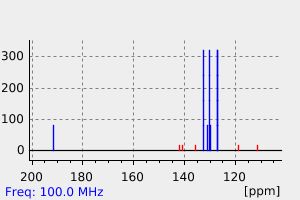(E)-4-(4-formylstyryl)benzonitrile | 862563-28-8
中文名称
——
中文别名
——
英文名称
(E)-4-(4-formylstyryl)benzonitrile
英文别名
4-[(1E)-2-(4-formylphenyl)ethenyl]benzonitrile;4-[(E)-2-(4-formylphenyl)vinyl]benzonitrile;4-[(E)-2-(4-formylphenyl)ethenyl]benzonitrile
CAS
862563-28-8
化学式
C16H11NO
mdl
——
分子量
233.269
InChiKey
NZEZRZPDYCNMAO-OWOJBTEDSA-N
BEILSTEIN
——
EINECS
——
-
物化性质
-
计算性质
-
ADMET
-
安全信息
-
SDS
-
制备方法与用途
-
上下游信息
-
文献信息
-
表征谱图
-
同类化合物
-
相关功能分类
-
相关结构分类
计算性质
-
辛醇/水分配系数(LogP):3.4
-
重原子数:18
-
可旋转键数:3
-
环数:2.0
-
sp3杂化的碳原子比例:0.0
-
拓扑面积:40.9
-
氢给体数:0
-
氢受体数:2
上下游信息
反应信息
-
作为反应物:描述:(E)-4-(4-formylstyryl)benzonitrile 在 cesiumhydroxide monohydrate 、 O-(6-chlorobenzo-triazol-1-yl)-N,N,N′,N′-tetramethyluronium hexafluorophosphate 、 sodium t-butanolate 作用下, 以 四氢呋喃 、 乙二醇二甲醚 、 水 、 N,N-二甲基甲酰胺 为溶剂, 反应 50.08h, 生成 cesium 4-((E)-4-((E)-4-((1,3-dihydroxy-2-(hydroxymethyl)propan-2-yl)carbamoyl)styryl)styryl)benzenesulfonate参考文献:名称:可见光诱导空穴注入固定在 Co3O4 和 SiO2 纳米颗粒上的整流分子线摘要:严格控制从可见光敏化剂到用于水氧化的金属氧化物纳米颗粒催化剂的电荷传输是开发高效人工光合作用系统的关键要求。通过利用共价锚定分子线将空穴从敏化剂传输到氧化物表面,可以解决电荷流的高速率和单向性的挑战。合成了具有各种锚定基团的 p-低聚(亚苯基亚乙烯基)(3 芳基单元,缩写为 PV3)类型的功能化空穴导电分子线,用于共价连接到 Co(3)O(4) 催化剂纳米颗粒,并有两种替代方法用于连接到引入氧化物纳米颗粒表面。完整的 PV3 分子在 Co(3)O(4) 纳米粒子(以及用于控制目的的 SiO(2) 纳米粒子)上的共价锚定是通过 FT-Raman、FT-IR 和光谱学建立的,包括在某些情况下观察锚定功能的振动特征。直接监测水溶液中可见光敏化剂的空穴转移动力学([Ru(bpy)(3)](2+)(和衍生物)光吸收剂,[Co(NH(3))(5)Cl] (2+) 受体) 到惰性 SiO(2)(12 nm)DOI:10.1021/ja306162g
-
作为产物:描述:4-溴苯腈 在 bis-triphenylphosphine-palladium(II) chloride 、 二(三叔丁基膦)钯 、 sodium carbonate 、 二异丙胺 作用下, 以 四氢呋喃 、 水 、 甲苯 为溶剂, 生成 (E)-4-(4-formylstyryl)benzonitrile参考文献:名称:咪唑作为Y型推挽生色团中的中心π键摘要:已设计,合成并充分表征了十二个基于咪唑的Y形推挽生色团,其特征在于4,5-双(N,N-二甲基苯胺基)咪唑为供体部分,系统地扩大了π-连接基,并以硝基和氰基为受体。已通过电化学,UV / Vis和IR光谱研究了合成的推挽系统,并计算了非线性光学性质。此外,还评估了测量和计算的特性与结构特征之间的定量关系。电化学和光谱性质主要受到强共轭受体,大π接头的存在以及发色团的空间排列的影响。DOI:10.1016/j.dyepig.2010.11.004
文献信息
-
Green synthesis and photophysical properties of novel 1 H -imidazo[4,5- f ][1,10]phenanthroline derivatives with blue/cyan two-photon excited fluorescence作者:Yu-Lu Pan、Zhi-Bin Cai、Li Bai、Fei-Fei Ma、Sheng-Li Li、Yu-Peng TianDOI:10.1016/j.tet.2017.03.075日期:2017.5developed for the synthesis of a series of novel 1H-imidazo[4,5-f][1,10]phenanthroline derivatives (1BN, 2Py, 3BI, 4BT, and 5MOBI) via a three–component, one–pot reaction under solvent–free conditions. Their structures were characterized by FT–IR, 1H NMR, 13C NMR, MS, and elemental analysis. Their photophysical properties, including linear absorption, one–photon excited fluorescence, two–photon absorption
-
[EN] OPTICAL DATA COMMUNICATION SYSTEM COMPRISING PARA-PHENYLENEVINYLENES AND SPECIFIC PARA-PHENYLENEVINYLENES<br/>[FR] SYSTÈME DE COMMUNICATION DE DONNÉES OPTIQUES COMPRENANT DES PARA-PHÉNYLÈNEVINYLÈNES ET DES PARA-PHÉNYLÈNEVINYLÈNES SPÉCIFIQUES申请人:BASF SE公开号:WO2019238532A1公开(公告)日:2019-12-19An optical data communication system comprising para-phenylenevinylenes, a receiver for an optical data communication system comprising para-phenylenevinylenes, a transmitter for an optical data communication system comprising para-phenylenevinylenes, the use of para- phenylenevinylenes in an optical data communication system, specific para-phenylenevinylenes and their preparation.
-
Synthesis and two-photon absorption properties of novel 2-substituted-4,5-diphenyl-1H-imidazoles作者:Guo-Chuang Zheng、Zhi-Bin Cai、Yu-Lu Pan、Li Bai、Yan-Tao Zhou、Sheng-Li Li、Yu-Peng TianDOI:10.1016/j.tet.2016.04.015日期:2016.6Novel 2-substituted-4,5-diphenyl-1H-imidazoles (M1–M4) were synthesized via a three-component, one-pot reaction under solvent-free conditions. The structures were characterized by infrared, hydrogen-1 nuclear magnetic resonance, carbon-13 nuclear magnetic resonance, mass spectrometry and elemental analysis. Their UV-visible absorption, single-photon excited fluorescence, two-photon absorption, and
-
Substituent-dependent reactivity in aldehyde transformations: 4-(phenylethynyl)benzaldehydes versus simple benzaldehydes作者:Isamu Katsuyama、Pandurang V. Chouthaiwale、Hai-Lei Cui、Yuji Ito、Ayumi Sando、Hiroaki Tokiwa、Fujie TanakaDOI:10.1016/j.tet.2013.03.056日期:2013.5Effects of substituents on transformations of 4-(phenylethynyl)benzaldehydes and related benzaldehydes were analyzed in aldol and thiazolidine formation reactions. The aldol reaction of 4-cyanobenzaldehyde was 54-fold faster than that of 4-methoxybenzaldehyde. In contrast, the aldol reaction of 4-(4-cyanophenylethynyl)benzaldehyde was only 1.4-fold faster than that of 4-(4-methoxyphenylethynyl)benzaldehyde
-
Synthesis, characterization and optical properties of π-conjugated systems incorporating closo-dodecaborate clusters: new potential candidates for two-photon absorption processes作者:R. Bernard、D. Cornu、P. L. Baldeck、J. Čáslavský、J.-M. Létoffé、J.-P. Scharff、P. MieleDOI:10.1039/b504414f日期:——Non-centrosymmetric Ï-conjugated systems incorporating closo-dodecaborate clusters, [NCâC6H4âC(H)N(H)âB12H11]â (2), [NCâC6H4âC(H)C(H)âC6H4âC(H)N(H)âB12H11]â (3), and [NCâC6H4âC(H)C(H)âC6H4âC(H)C(H)âC6H4âC(H)N(H)âB12H11]â (4) have been synthesized by reaction of the monoamino derivative of B12, [B12H11NH3]â (1), with various arylaldehydes, RâC6H4âCHO. These Schiff base-like compounds were fully characterized by multinuclear NMR spectroscopy and mass spectrometry. In order to evaluate these boron rich Ï-systems as potential materials for two-photon absorption (TPA) processes, UV linear absorption curves were recorded for 3 and 4, and comparatively studied with those of the boron-free Ï-systems NCâC6H4âC(H)NâCH3 (5) and NCâC6H4âC(H)C(H)âC6H4âC(H)NâCH3 (6). The donor effect of the boron cluster was evidenced by a shift to the lower energy of the absorption band in the spectra of systems incorporating B12. The two photon absorption (TPA) spectrum of compound 3, obtained by the up-conversion method, shows a resonance at 720 nm with a cross-section ÏTPA of 35 Ã 10â50 cm4 s photonâ1 moleculeâ1. This value suggests the potential of B12 clusters to be used as new donor groups for the synthesis of non-linear materials.非中心对称的Ï-共轭体系,其中包含[NCâC6H4âC(H)N(H)âB12H11]â (2),[NCâ âC(H)C(H)â âC(H)N(H)âB12H11]â (3)、和[NCâ âC(H)C(H)â âC(H)C(H)â âC(H)N(H)âB12H11]â (4)是通过 B12 的单氨基衍生物[B12H11NH3]â (1) 与各种芳基醛 Râ âCHO 反应合成的。通过多核核磁共振波谱和质谱分析,这些类似希夫碱的化合物得到了全面的表征。为了评估这些富硼Ï-体系作为双光子吸收(TPA)过程潜在材料的价值,我们记录了 3 和 4 的紫外线性吸收曲线,并将其与无硼Ï-体系 NCâ âC(H)NâCH3 (5) 和 NCâ âC(H)C(H)â âC(H)Nâ (6) 的吸收曲线进行了比较研究。在含有 B12 的体系光谱中,硼团簇的供体效应表现为吸收带向低能量方向移动。通过上转换法获得的化合物 3 的双光子吸收(TPA)光谱显示,在 720 纳米波长处存在共振,其横截面 ÏTPA 为 35 Ã 10â50 cm4 s 光子â1 moleculeâ1。这一数值表明,B12 团簇有可能被用作合成非线性材料的新供体基团。
表征谱图
-
氢谱1HNMR
-
质谱MS
-
碳谱13CNMR
-
红外IR
-
拉曼Raman
-
峰位数据
-
峰位匹配
-
表征信息
同类化合物
(E,Z)-他莫昔芬N-β-D-葡糖醛酸
(E/Z)-他莫昔芬-d5
(4S,5R)-4,5-二苯基-1,2,3-恶噻唑烷-2,2-二氧化物-3-羧酸叔丁酯
(4S,4''S,5R,5''R)-2,2''-(1-甲基亚乙基)双[4,5-二氢-4,5-二苯基恶唑]
(4R,5S)-4,5-二苯基-1,2,3-恶噻唑烷-2,2-二氧化物-3-羧酸叔丁酯
(4R,4''R,5S,5''S)-2,2''-(1-甲基亚乙基)双[4,5-二氢-4,5-二苯基恶唑]
(1R,2R)-2-(二苯基膦基)-1,2-二苯基乙胺
鼓槌石斛素
黄子囊素
高黄绿酸
顺式白藜芦醇三甲醚
顺式白藜芦醇
顺式己烯雌酚
顺式-白藜芦醇3-O-beta-D-葡糖苷酸
顺式-桑皮苷A
顺式-曲札芪苷
顺式-二苯乙烯
顺式-beta-羟基他莫昔芬
顺式-a-羟基他莫昔芬
顺式-3,4',5-三甲氧基-3'-羟基二苯乙烯
顺式-1-(3-甲基-2-萘基)-2-(2-萘基)乙烯
顺式-1,2-双(三甲基硅氧基)-1,2-双(4-溴苯基)环丙烷
顺式-1,2-二苯基环丁烷
顺-均二苯乙烯硼酸二乙醇胺酯
顺-4-硝基二苯乙烯
顺-1-异丙基-2,3-二苯基氮丙啶
非洲李(PRUNUSAFRICANA)树皮提取物
阿非昔芬
阿里可拉唑
阿那曲唑二聚体
阿托伐他汀环氧四氢呋喃
阿托伐他汀环氧乙烷杂质
阿托伐他汀环(氟苯基)钠盐杂质
阿托伐他汀环(氟苯基)烯丙基酯
阿托伐他汀杂质D
阿托伐他汀杂质94
阿托伐他汀杂质7
阿托伐他汀杂质5
阿托伐他汀内酰胺钠盐杂质
阿托伐他汀中间体M4
阿奈库碘铵
锌(II)(苯甲醛)(四苯基卟啉)
银松素
铜酸盐(5-),[m-[2-[2-[1-[4-[2-[4-[[4-[[4-[2-[4-[4-[2-[2-(羧基-kO)苯基]二氮烯基-kN1]-4,5-二氢-3-甲基-5-(羰基-kO)-1H-吡唑-1-基]-2-硫代苯基]乙烯基]-3-硫代苯基]氨基]-6-(苯基氨基)-1,3,5-三嗪-2-基]氨基]-2-硫代苯基]乙烯基]-3-硫代
铒(III) 离子载体 I
铀,二(二苯基甲酮)四碘-
钾钠2,2'-[(E)-1,2-乙烯二基]二[5-({4-苯胺基-6-[(2-羟基乙基)氨基]-1,3,5-三嗪-2-基}氨基)苯磺酸酯](1:1:1)
钠{4-[氧代(苯基)乙酰基]苯基}甲烷磺酸酯
钠;[2-甲氧基-5-[2-(3,4,5-三甲氧基苯基)乙基]苯基]硫酸盐
钠4-氨基二苯乙烯-2-磺酸酯







